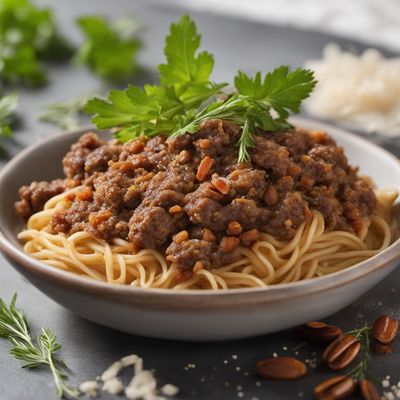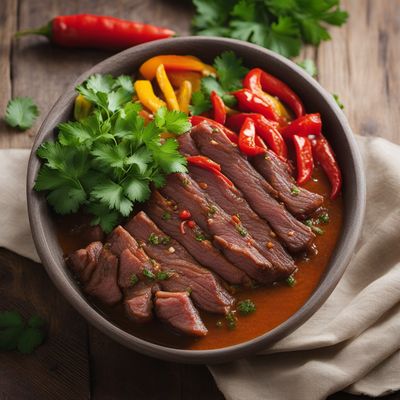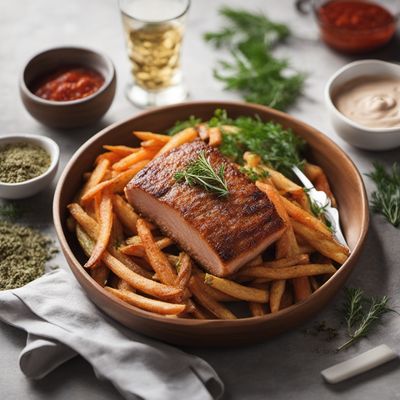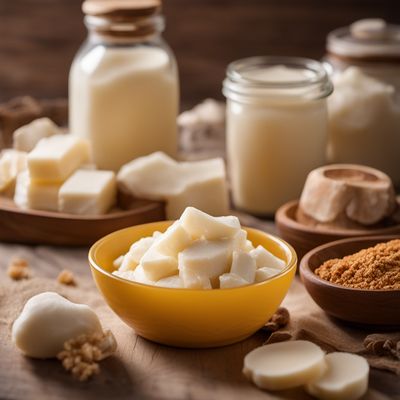
Ingredient
Pork lard
The Versatile Fat: Pork Lard
Pork lard is a rendered fat obtained from the fatty tissues of pigs. It is solid at room temperature and has a creamy white color. With a high smoke point, it is perfect for frying and sautéing, providing a distinct savory flavor and a crispy texture to dishes. Its creamy consistency also makes it an excellent ingredient for baking, adding moisture and tenderness to pastries and breads.
Origins and history
Pork lard has been used in cooking for centuries and is a staple in many cuisines around the world. It has a long history, dating back to ancient times, where it was highly valued for its versatility and flavor-enhancing properties. In traditional Chinese cuisine, pork lard is commonly used for stir-frying and deep-frying, while in Mexican cuisine, it is a key ingredient in making tamales and refried beans. Its rich flavor and ability to enhance the taste of other ingredients have made it a beloved fat in culinary traditions worldwide.
Nutritional information
Pork lard is a good source of vitamin D and contains a balanced ratio of saturated, monounsaturated, and polyunsaturated fats. It is also rich in oleic acid, which is known to have heart-healthy benefits. However, it is high in calories, so moderation is key when incorporating it into your diet.
Allergens
Pork lard may contain allergens such as pork proteins, which can trigger allergic reactions in individuals with pork allergies.
How to select
When selecting pork lard, look for a creamy white color and a firm texture. Avoid lard that has a yellowish tint or a rancid smell, as these are signs of spoilage. Opt for lard from pasture-raised pigs, as it tends to have a richer flavor and higher quality. If possible, choose lard that is minimally processed and free from additives or preservatives.
Storage recommendations
To maintain the freshness and quality of pork lard, store it in an airtight container in the refrigerator. It can last for several months when stored properly. If you have a large quantity, you can also freeze it for longer-term storage. Make sure to label the container with the date to keep track of its freshness.
How to produce
Pork lard can be produced by rendering the fat from pork. To do this, cut the fat into small pieces and heat it over low heat until it melts completely. Strain the liquid fat to remove any impurities, and then allow it to cool and solidify before storing it in an airtight container.
Preparation tips
Pork lard can be used in various cooking techniques, such as frying, sautéing, and baking. When frying, its high smoke point makes it ideal for achieving crispy and golden results. Use it to fry chicken, potatoes, or even doughnuts for a deliciously indulgent treat. In baking, substitute pork lard for butter or vegetable shortening to add moisture and tenderness to pastries, biscuits, and pie crusts. It can also be used as a flavorful base for making confit or as a spread on bread for added richness.
Substitutions
Butter, vegetable shortening, or duck fat can be used as substitutes for pork lard in recipes. However, keep in mind that the flavor and texture may vary slightly.
Culinary uses
Pork lard is commonly used in various cuisines around the world. It is a key ingredient in Mexican tamales, refried beans, and carnitas. In Chinese cuisine, it is used for stir-frying and deep-frying, adding a rich flavor to dishes like mapo tofu and salt and pepper pork chops. In European cuisines, pork lard is used for making flaky pastries, such as French croissants and Danish pastries. It is also used in traditional British recipes like pork pies and Yorkshire puddings.
Availability
Pork lard is commonly available in regions where pork is a staple meat, such as North America, Europe, and parts of Asia. It is widely used in Mexican, Chinese, and European cuisines.
More ingredients from this category
Recipes using Pork lard » Browse all

Peranakan-style Pork Roast
Nyonya-inspired Pork Roast: A Fusion of German and Peranakan Flavors

Soulful Roasted Veal
Soulful Roasted Veal: A Tender Delight with a Southern Twist

Turkmen-inspired Grilled Pork Tenderloin and Sausages with Pickled Cabbage
Sizzling Turkmen Delight: Grilled Pork and Sausages with Tangy Pickled Cabbage

Corsican Montasù with a Twist
Savory Delight: Corsican Montasù with a Modern Twist

Roasted Pork with Crispy Crackling
Nordic Delight: Crispy Roasted Pork with a Danish Twist

Cochinita Pibil - Spanish Style
Sabrosa Cochinita Pibil: A Spanish Twist on a Mexican Classic

Salsiccia alla Campania
Savory Salsiccia Delight: A Taste of Campania

Madurese-style Selsko Meso
Spicy and Savory Madurese Selsko Meso: A Fusion of Bulgarian and Indonesian Flavors

New Nordic Katsudon
Nordic-Style Crispy Pork Cutlet with Rice and Egg

Saxon-Style Steamed Cheeseburger
Savory Steamed Delight: Saxon-Style Cheeseburger

Frygadeli - Danish Delight
Crispy Danish Pork Fritters with a Twist

Monégasque-inspired Loukaniko Sausage
Mediterranean Delight: Monégasque-inspired Loukaniko Sausage

